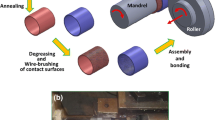Abstract
The aim of this work is to produce two layered thin-walled Cu/Al composite tube by the spin-bonding process. The process is utilized to bond the aluminum tube into the copper one at thickness reductions of 20–60% and process temperatures of 25°C, 130°C, and 230°C. The bond strength is measured by T-peeling test, and the bond interfaces are examined by metallography and scanning electron microscopy (SEM). The results show that after a threshold thickness reduction of about 30%, the bond strength increased with the amount of deformation. SEM fractography of the peel surfaces confirms that the copper oxide film is broken in a shear manner during deformation. Severe shear strains applied during spin-bonding process, in fact, make it appropriate for bonding the copper to aluminum. Based on the results, at higher temperatures the resulted bond strength is decreased. It is shown that formation of the brittle intermetallic layer on the interface at high temperatures leads to decrease in the bond strength. In addition to the experiments, a procedure is proposed by which it is possible to calculate the bonding length through the comparison of FEM simulations and the experiments. Based on these calculations and the bonding mechanism, a bond strength model is developed and verified by the experiments.
Similar content being viewed by others
References
Peng XK, Heness G, Yeung WY (1999) Effect of rolling temperature on interface and bond strength development of roll bonded copper/aluminium metal laminates. J Mater Sci 34:277–281
Abbasi M, Taheri AK, Salehi MT (2001) Growth rate of intermetallic compounds in Al/Cu bimetal produced by cold roll welding process. J Alloys Compd 319:233–241
Zhan Z et al (2006) Cladding inner surface of steel tubes with Al foils by ball attrition and heat treatment. Surf Coat Technol 201:2684–2689
Heness G, Wuhrer R, Yeung WY (2008) Interfacial strength development of roll-bonded aluminium/copper metal laminates. Mater Sci Eng A 483–484:740–742
Mohamed HA, Washburn J (1975) Mechanism of solid state pressure welding. Weld J 54:302s–310s
Peng XK et al (1999) On the interface development and fracture behaviour of roll bonded copper/aluminium metal laminates. J Mater Sci 34:2029–2038
Peng XK (2000) Rolling strain effects on the interlaminar properties of roll bonded copper/aluminium metal laminates. J Mater Sci 35:4357–4363
Lee JE et al (2007) Effects of annealing on the mechanical and interface properties of stainless steel/aluminum/copper clad-metal sheets. J Mater Process Technol 187–188:546–549
Chen Z et al (2003) Fabrication of composite pipes by multi-billet extrusion technique. J Mater Process Technol 137:10–16
Sponseller DL, Timmons GA, Bakker WT (1998) Development of clad boiler tubes extruded from bimetallic centrifugal castings. J Mater Eng Perform 7:227–238
Berski S et al (2006) Analysis of quality of bimetallic rod after extrusion process. J Mater Process Technol 177:582–586
Wang X, Lib P, Wang R (2005) Study on hydro-forming technology of manufacturing bimetallic CRA-lined pipe. Int J Mach Tools Manuf 45:373–378
Mohebbi MS, Akbarzadeh A (2010) A novel spin-bonding process for manufacturing multilayered clad tubes. J Mater Process Technol 210:510–517
Wong CC, Dean TA, Lin J (2003) A review of spinning, shear forming and flow forming processes. Int J Mach Tools Manuf 43:1419–1435
Wong CC, Dean TA, Lin J (2004) Incremental forming of solid cylindrical components using flow forming principles. J Mater Process Technol 153–154:60–66
Vaidyanath LR, Nicholas MG, Milner DR (1959) Pressure welding by rolling. Br Weld J 6:13–28
Cave JA, Williams JD (1975) The mechanisms of cold pressure welding by rolling. J Inst Met 101:203–207
Bay N (1986) Cold welding: Part I. Characteristic, bonding mechanisms, bond strength. Met Constr 18:369–372
Wright PK, Snow DA, Tay CK (1978) Interfacial conditions and bond strength in cold pressure welding by rolling. Met Technol 1:24–31
Li L, Nagai K, Yin F (2008) Progress in cold roll bonding of metals. Sci Technol Adv Mater 9:1–12
Mohebbi MS, Akbarzadeh A (2010) Experimental study and FEM analysis of redundant strains in flow forming of tubes. J Mater Process Technol 210:389–395
Hwang YM, Hsu HH, Hwang YL (2000) Analytical and experimental study on bonding behavior at the roll gap during complex rolling of sandwich sheets. Int J Mech Sci 42:2417–2437
Author information
Authors and Affiliations
Corresponding author
Rights and permissions
About this article
Cite this article
Mohebbi, M.S., Akbarzadeh, A. Fabrication of copper/aluminum composite tubes by spin-bonding process: experiments and modeling. Int J Adv Manuf Technol 54, 1043–1055 (2011). https://doi.org/10.1007/s00170-010-3016-5
Received:
Accepted:
Published:
Issue Date:
DOI: https://doi.org/10.1007/s00170-010-3016-5



